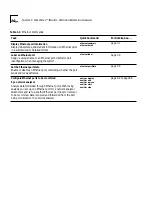
Using Menus to Perform Tasks
2-9
If you enter a command incorrectly, you receive a prompt telling you that
what you entered was not valid or was ambiguous. You must re-enter the
command from the point at which it became incorrect.
Entering Values
When you reach the level at which you perform a specific task, you are
prompted for a value. The prompt usually shows all valid values (if
applicable) and sometimes a suggested default value. The default might be
the system default or the current user-defined value of that parameter.
The valid values are displayed in parentheses. The default value is in
brackets. In this example, (
disabled, enabled
) are the valid values.
[
Enabled
], shown in brackets, is the default:
Enter a new value (disabled,enabled) [enabled]:
Entering values in
command strings
A command string can also contain the value of a command parameter.
If you enter a value at the end of a command string, the task is completed,
and you are returned to the previous menu. For example, to disable a
baseline from the top-level menu, enter:
Select a menu option:
system baseline requestedState
disabled
Getting Out
To return to the menu one step higher in the hierarchy or to cancel an
operation that you are currently performing, enter
q
, followed by [Return].
To quickly move to the top-level menu without backtracking through
menus, press [Esc] (the Escape key). You immediately return to the top-level
menu.
To completely leave the Administration Console, see the section “Exiting the
Administration Console” on page 2-17.
Содержание SUPERSTACK 2200
Страница 41: ......
Страница 75: ......
Страница 173: ...13 12 CHAPTER 13 CONFIGURING ADDRESS AND PORT GROUPS TO USE IN PACKET FILTERS ...
Страница 174: ...V Appendix A Packet Filter Opcodes Examples and Sytax Errors Appendix B Technical Support APPENDIXES ...
















































